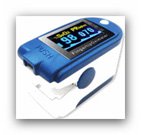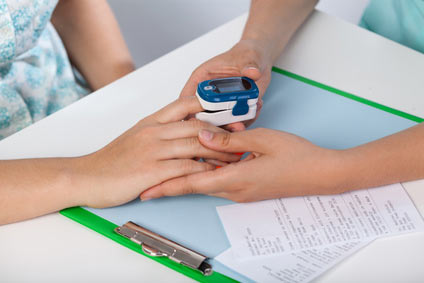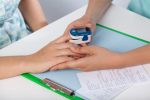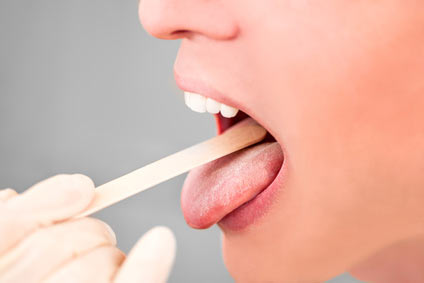Portable Pulse Oximeter
How to Use an Oximeter to Track your sleep apnea treatment
If you have sleep apnea, a portable pulse oximeter can be very useful in monitoring your blood oxygen level (oxygen saturation) during sleep.
In fact, the sleep apnea oximeter will show you how efficient is your apnea treatment.
If your oxygen levels are below 92%, then your treatment is not effective enough1. You should maintain O2 levels above 98% when sleeping2.
Are you wondering if your sleep apnea is under control? Do you want to know if you have healthy oxygen levels during sleep? In this page, you'll learn how to monitor your sleep with a cheap but effective portable pulse oximeter.
Sleep Apnea and Blood Oxygen Levels
What causes oxygen desaturation in sleep apnea?
If you wake up with a pounding feeling in your chest, or wake up with irregular heart beats, it could be that you might have a severe case of sleep apnea.
When breathing stops during sleep, a person will receive less air, resulting in low blood oxygen levels.
In severe cases, the low oxygen levels can put pressure on the left ventricle of your heart. Your body reads this as needing to relieve blood pressure, by creating and releasing urine3.
In other words, with untreated obstructive sleep apnea, you really can't get a good night sleep at all, no matter what.
The following video has a clear demonstration of oxygen desaturation during sleep apnea, where the device used for this explanation is a finger oximeter:
What is a good oxygen level during sleep?
Oxygen saturation over 95% is considered normal. Anything below 92% oxygen in your blood is a sign that you have breathing problems during sleep (sleep apnea, severe snoring, COPD, asthma, etc).
However, it's important to know how much time did you spend with oxygen saturation that goes below 92%.
There can be drops in oxygen levels that are not long enough or low enough to be called abnormal or unhealthy for your body. For example, a couple of seconds with 80% for two times in one night is not a reason for concern.
If you want to discover your blood oxygen levels during your sleep, you could go to a sleep lab to have an overnight sleep study, or you can use a monitor that can be used at home.
The pulse oximeter, or the oxygen saturation monitor, can be a very useful medical device for sleep apnea patients. It's much cheaper than a sleep study, and it can reveal important information about your sleep quality or how effective is your sleep apnea treatment.
Pulse Oximeter for Sleep Apnea
What is a portable pulse oximeter?
A pulse oximeter provides a record of your blood oxygen levels and heart rate while you wear the device. This information is essential for monitoring the quality of your sleep, mostly if you know you have apnea episodes during sleep.
Finding the best portable pulse oximeter for sleep apnea

If you can, get a hold of a pulse oximeter with alarm which can clip to your finger, or wear on your wrist, that would give you and your doctor a good idea of how badly you are desaturating your oxygen levels.
The following video explains why it's so important to use the portable pulse oximeter if you have (or have a high risk of) sleep apnea:
Sleep apnea pulse oximeters are expensive and generally not covered by insurance. However, finger pulse oximeters with recording capabilities can be found at much lower prices.
If you want an oximeter that can help you monitor your CPAP treatment and give you a sleep data analysis, you could consider buying the Viatom Sleep Oxygen Monitor:
This portable pulse oximeter has useful features for a person who wants to monitor his sleep apnea at home, or to diagnose sleep apnea:
- can record the data and then you can analyze it.
- it can alarm you on high and low limits.
- smart vibration for snoring reducing.
- free App for mobile that shows the sleep report graphic
How to use the pulse oximeter for sleep apnea
The following video explains how to read the information from the pulse oximeter to understand if you had apnea episodes during sleep:
Do you want wireless finger oximeter?
Although CMS50D Plus is one of the best cheapest portable pulse oximeter, an upgraded device with wireless interface to your computer will sound more interesting.
I'm talking about the wireless pulse oximeter CMS-50E, which is just a little more expensive that CMS50D+.
Here is how to use CMS-50E finger pulse oximeter:
Pulse Oximetry and Sleep Apnea
Can a pulse oximeter tell if you have sleep apnea?
A sleep apnea pulse oximeter can record your blood oxygen levels and heart rate, but can not indicate whether the drops in saturation and the increased heart rate are caused by apnea episodes or arousals from sleep.
Furthermore, it's also possible that the drops in oxygen levels are caused by other disorders, such as asthma or COPD.
Another interesting thing is that there are few patients with severe sleep apnea with over 70 apnea events on hour, and their oxygen levels barely drop. But this usually happens when the sleep clinics or patients are using non-standardized oximeter devices for their assessment.
Studies demonstrate how useful is the oximeter to diagnose sleep apnea. Scientists compared the efficiency between Polysomnography and Overnight Oximetry in 68 patients with an AHI > 15.
The results were surprising: scientists successfully diagnosed the patients only using Epworth Sleepiness Scale (ESS) score, Sleep Apnea Clinical Score, and overnight oximetry.
Can you trust a portable pulse oximeter?
A portable pulse oximeter can be very useful in verifying therapies where you have an underlying lung disease such as asthma or COPD.
If you already know that you have sleep apnea, a portable pulse oximeter will help you monitor the effectiveness of your treatment.
You just have to wear the oximeter on your finger while sleeping, and then check in the morning the recorded data on your computer.
As this clinical study demonstrates, pulse oximetry makes it easy to use for sleep apnea screening, and this method was highly effective in detecting individuals with severe OSA.
Bottom line... A pulse oximeter is not always the best way to diagnose sleep apnea. But the information provided is very helpful.
Oxygen Saturation Monitor Tips
Insurances won't BUY an oximeter for home use but they will pay for the overnight oximetry service provided by local DME suppliers.
And generally, insurances, including Medicare, will NOT pay for oximeter equipment, even for someone with chronic obstructive pulmonary disease (COPD).
What you CAN do is ask your doctor to script an overnight oximetry whilst using your CPAP. Your DME provider will provide you with an oximeter for use overnight. It is just a finger clip on such as you used during your split-night PSG and the "box" is about the same size as a paperback book.
The oximeter is picked up by or returned to your DME provider the following morning and the oximetry data is downloaded and FAXed to your ordering doctor. On the basis of that data your doctor may or may not see fit to order 02 supplementation w/your PAP.
Bottom line... The oximetry test is not
sufficient enough to determine whether someone has sleep apnea.
However, a portable pulse oximeter is always helpful if you have sleep breathing disorders, and remember that the price of the device is not so high compared with the important information that you can get.
Last Update: 09/07/2018
Relevant Articles
References
1. Low oxygen saturation and mortality in an adult cohort: the Tromsø study - Monica Linea Vold, Ulf Aasebø, Tom Wilsgaard, and Hasse Melbye (BMC Pumonary Medicine, 2015)
2. Normal oxygen saturation values in pediatric patients - Mau MK1, Yamasato KS, Yamamoto LG (Hawaii Medical Journal, 2005)
3. Clinical predictors of nocturia in the sleep apnea population - Omer A Raheem, Ryan K Orosco,1 Terence M Davidson,1 and Charles Lakin (Urology Annals, 2014)
Sleep Apnea › Sleep Apnea Equipment › Portable Pulse Oximeter









New! Comments
Have your say about what you just read! Leave me a comment in the box below.